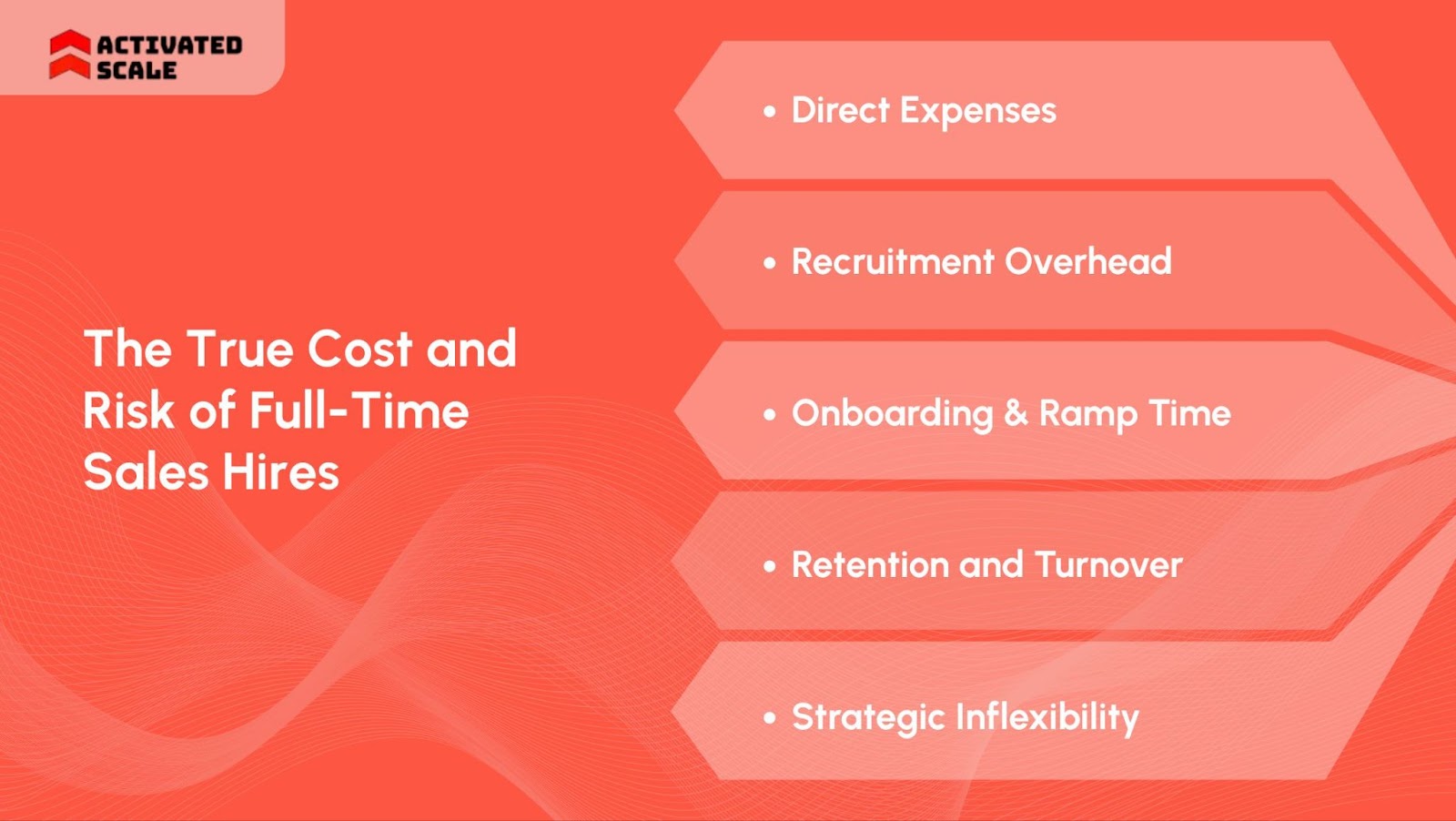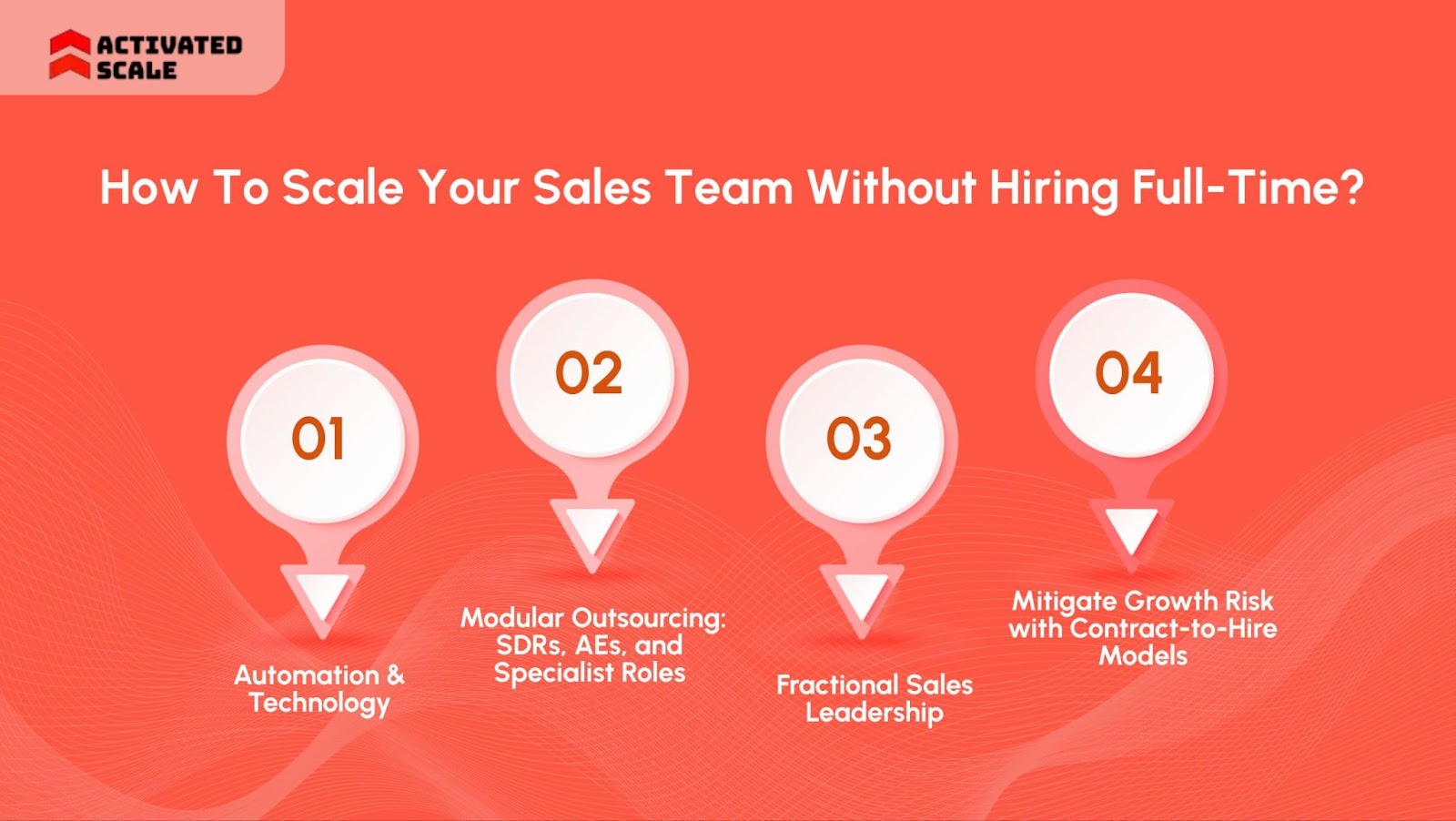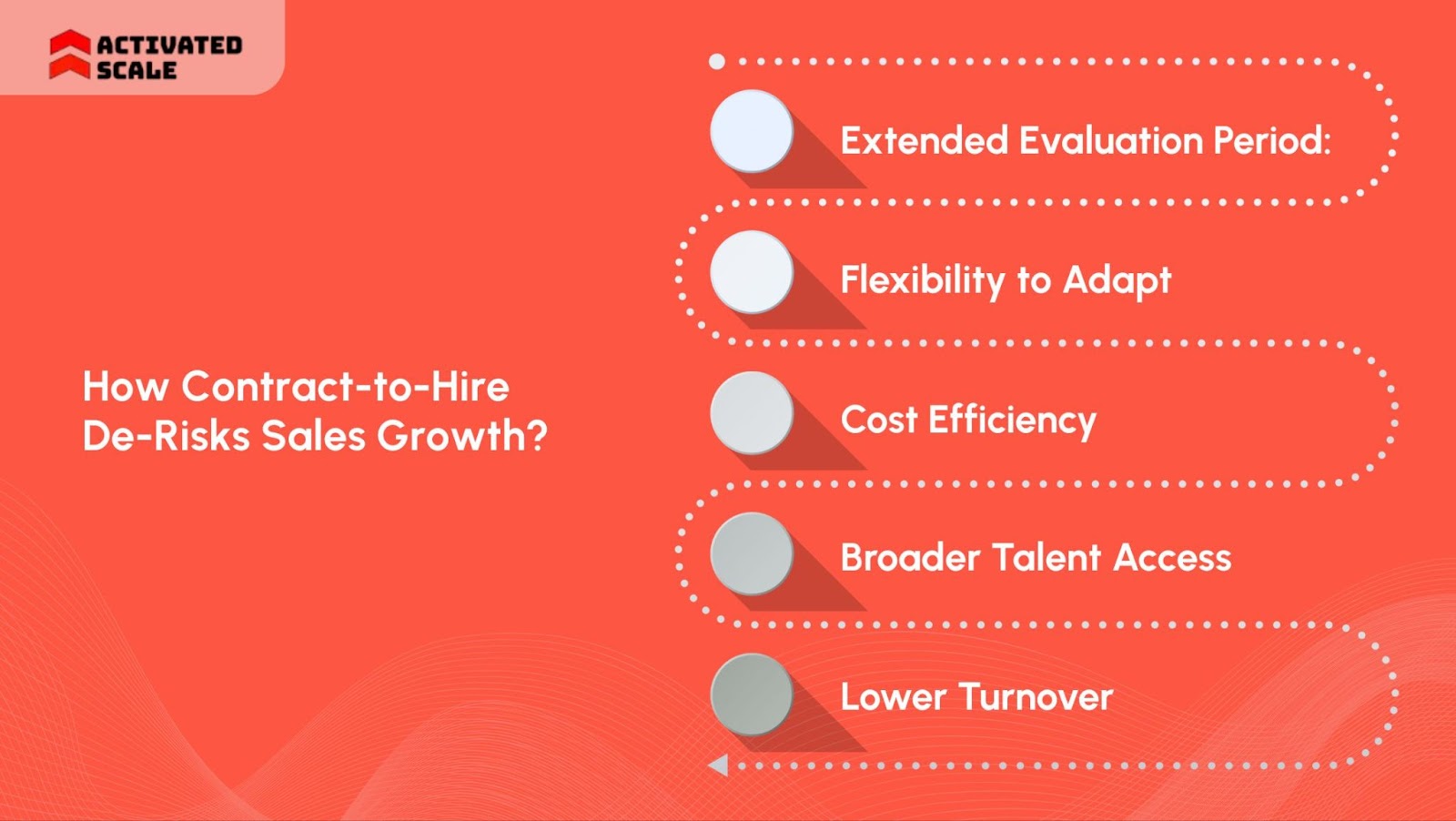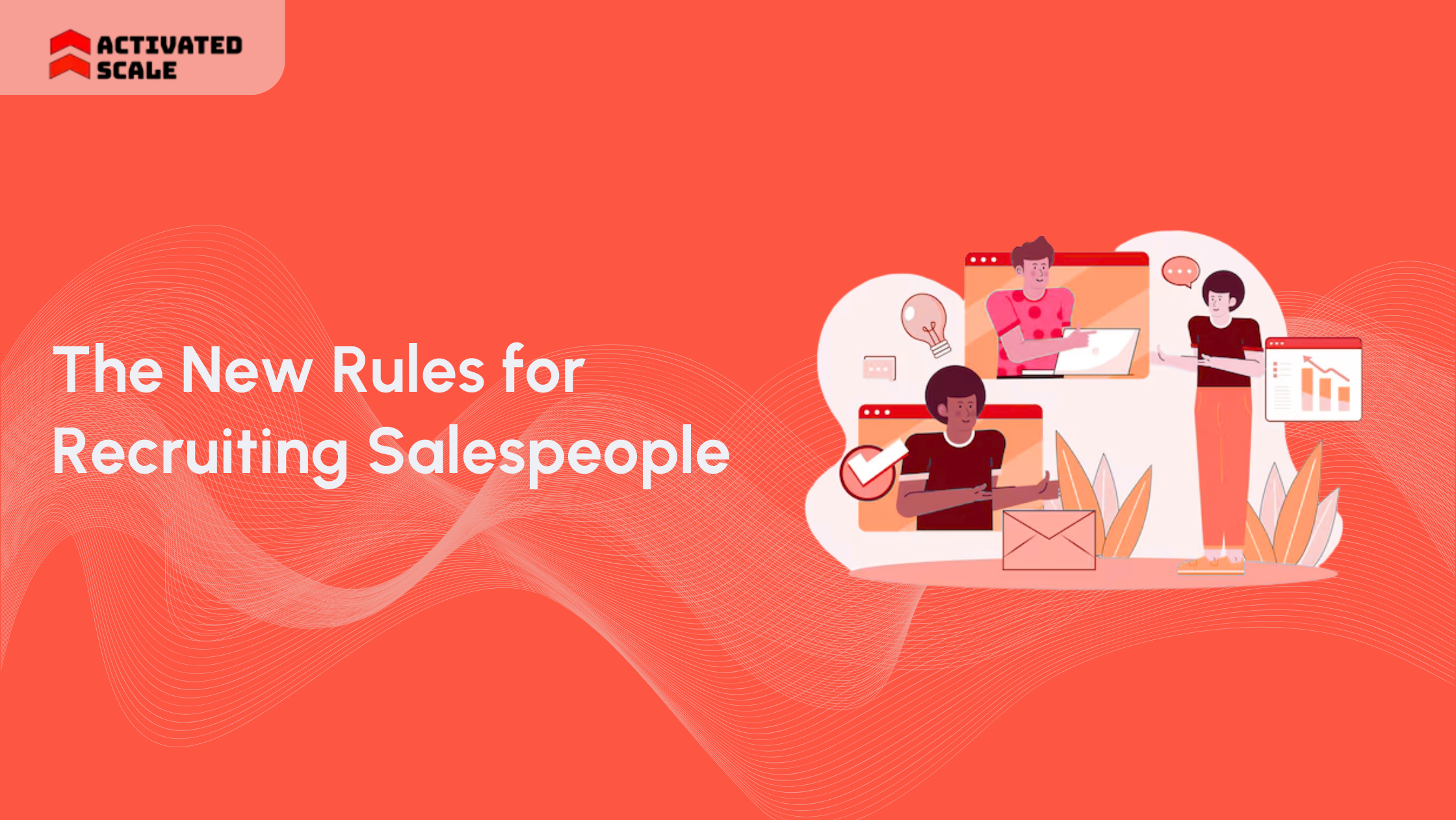Every founder and sales leader eventually has the moment when ambition outpaces headcount. The market shifts, targets tighten, and every hire becomes an investment scrutinized from every angle.
Yet, the reality of traditional hiring can be costly. In 2025, adding a new sales representative can cost between $7,000 and $15,000 or more, factoring in recruiting, onboarding, ramp time, and hidden overhead.
That’s assuming you even find the right talent, as recent data shows that more than 50% of sales reps will miss their quotas this year. For many businesses, these numbers are roadblocks standing between today’s growth pains and tomorrow’s big wins.
This blog covers how you can break the status quo, and go for a smarter, faster, more resilient way to scale one that delivers sales results without burying your team in risk or cost.
In a Nutshell
- Scaling your sales team doesn’t require full-time hires; instead, focus on flexible solutions like fractional leadership and contract-to-hire talent.
- Full-time sales hires come with significant hidden costs, including recruitment, onboarding, and high turnover rates.
- Automation tools streamline sales tasks, allowing teams to work more efficiently without increasing payroll.
- Activated Scale offers tailored solutions to help businesses scale smarter, offering experienced sales talent exactly when needed without the overhead of traditional hires.
Why Scaling Your Sales Team Doesn’t Mean More Full-Time Hires
Adding bodies to the organization does not define scaling, rather it’s about multiplying outcomes. When founders and revenue leaders face the pressure to grow, the instinct is often to reach for the hiring button.
But relying solely on full-time sales hires today comes with hidden burdens that stretch far beyond salary figures. To build a sales engine that’s future-proof and financially sane, it’s time to rethink what growth actually requires.
If you’re ready to move beyond the traditional hiring treadmill and build a sales team that’s agile, scalable, and outcome-focused, consider partnering with Activated Scale. We specialize in providing fractional and contract-to-hire sales talent and leadership, helping you plug critical gaps quickly and without the long-term risk.
The True Cost and Risk of Full-Time Sales Hires

Consider the layers beneath the surface of a full-time sales hire:
- Direct Expenses: Base salary, commissions, benefits, equipment, and required tech stack licenses can easily run into six figures annually, especially for experienced SDRs or AEs.
- Recruitment Overhead: Sourcing, interviewing, background checks, and the lost time spent out of the field all drain attention and resources.
- Onboarding & Ramp Time: The typical new sales rep can require three to six months (or more) to reach full productivity. During this ramp period, pipeline stalls and quotas are missed.
- Retention and Turnover: Sales has one of the highest turnover rates of any profession. Reports show annual turnover of 35% or greater is common. Every exit means another cycle of cost, lost pipeline, and disruption.
- Strategic Inflexibility: Full-time hires are hard to scale up or down in response to shifting markets, new business models, or temporary campaign surges. When needs change, companies face the dual pain of layoffs and lost institutional knowledge.
Do More With Less Through Creative Resourcing
Challenging the assumption that "more hires = more sales" unlocks strategic advantages:
- Agility Wins: With flexible staffing (fractional reps and leadership, contract-to-hire, specialized outsourcing), teams deploy skills exactly when and where they’re needed.
- Risk Mitigation: Creative resourcing allows businesses to trial new roles, markets, or playbooks without the financial commitment of a full headcount. If a segment underperforms or priorities shift, you can pivot without sunk costs.
- Operational Leverage: Contract and fractional talent are often highly experienced. They ramp up in weeks, not months, bringing proven process expertise and reducing your manager's burden.
- Resource Optimization: Instead of locked-in payroll, growth-stage companies can invest in enablement tools, targeted marketing, or analytics. This “budget agility” paves the way for smarter experimentation and faster learning cycles.
How To Scale Your Sales Team Without Hiring Full-Time

Scaling your sales team can be a challenge, especially when traditional hiring feels like the only option. But what if there’s a smarter, more flexible way to grow that aligns with your evolving business needs? We’ll discuss how to achieve this below.
1. Automation & Technology
Automating routine sales tasks allows your team to work smarter, not harder. Many tools enable automation of lead enrichment, email sequences, follow-ups, CRM updates, and reporting, accelerating pipeline growth without ballooning payroll.
How Automation Supports Sales Teams
- Streamlined Outreach and Follow-Up:
Automate personalized cold email campaigns, sequence follow-ups, and multi-channel touchpoints to keep leads engaged consistently without manual effort. - Lead Enrichment & Prioritization:
Automatically gather firmographic and behavioral data to enrich leads and prioritize outreach, so reps can focus on the hottest prospects. - CRM Automation:
Reduce manual data entry by syncing interactions, logging calls and emails, and updating deal stages automatically, improving data accuracy and freeing time. - Reporting & Analytics:
Real-time dashboards and automated reports help sales leaders monitor team performance and funnel health without assembling spreadsheets.
When Automation is a Multiplier, Not a Replacement
Automation enhances human sales efforts but doesn’t replace them. Here’s why:
- Sales conversations require empathy, adaptability, and real-time problem-solving that AI cannot replicate.
- Automation frees reps from repetitive administrative work, enabling them to spend more time on consultative selling and closing deals.
- Human oversight ensures sequences and messaging feel tailored, preventing robotic or spammy outreach that can damage relationships.
Also Read: Are Tech Sales Bootcamps Worth It? Busting the Common Myths
2. Modular Outsourcing: SDRs, AEs, and Specialist Roles
Outsourcing sales roles on a modular basis means engaging Sales Development Representatives (SDRs), Account Executives (AEs), or specialist sales roles as flexible, contract-based resources instead of full-time hires.
This model offers companies powerful flexibility and rapid scalability without the risks and costs inherent in traditional recruitment.
The Power and Process of Modular Outsourcing
- Flexibility to Scale Quickly: Outlining workforce needs with precision, companies can bring in modular sales reps exactly when surges in demand or market testing require an expanded outreach or closing capacity.
- Cost and Risk Mitigation: Outsourced reps eliminate long-term employment costs like benefits and severance. Engagements can be paused or ended without expensive layoffs or organisational disruption.
- Specialist Skill Access: Modular roles allow targeted hiring of expertise, like technical sales specialists or industry veterans on demand.
- Fast Ramp Time: Experienced outsourced reps can jump into campaigns with minimal onboarding due to their prior exposure to diverse products and markets.
Typical Use Cases
- Market Testing: Companies can trial new verticals, geographies, or products by contracting experienced SDRs or AEs for short to mid-term engagements, assessing viability with minimal risk.
- Campaign Surges: Seasonal peaks, product launches, or specific outbound campaigns can be powerfully bolstered with scalable external talent resources.
- Temporary Gaps & Pilot Programs: Quickly fill absences, maternity leaves, or pilot strategic initiatives without burdening permanent payroll.
Also Read: How Outsourced SDRs Can Transform Your Sales Pipeline in 2025
3. Fractional Sales Leadership
Fractional sales leadership refers to engaging senior sales executives like VPs or CROs on a part-time, flexible basis to provide high-impact leadership without full-time costs or commitments.
This model is especially suited for startups and SMBs that need expert guidance to scale effectively but cannot justify or afford full-time sales leadership.
What Fractional Leadership Brings
- Strategic GTM (Go-To-Market) Planning: Fractional leaders analyze current sales practices, align strategies with business goals, and design scalable sales frameworks.
- Process Design & Playbook Optimization: They assess sales funnels, diagnose bottlenecks, refine messaging, and implement structured, repeatable processes that enhance conversion and pipeline velocity.
- Team Development & Coaching: Beyond strategy, fractional leaders focus on ramping up internal teams, coaching underperformers, scaling top-performers, and cultivating a sales-driven culture.
- Data-Driven Execution: They establish KPIs (e.g., meetings booked, pipeline coverage, win rates), monitor performance in real-time, and drive accountability with regular reviews.
- Rapid GTM Validation: Fractional executives can quickly test new markets or products, stress-test discovery calls, and optimize sales motions based on data, not guesswork, significantly shortening feedback cycles.
Difference Between Permanent and Fractional Sales Leadership
- Cost Efficiency: Fractional sales leaders work fewer days per week (commonly 2-3 days), providing executive-level expertise at a fraction of full-time costs and commitments.
- Scalability and Flexibility: Businesses engage fractional leaders for defined periods (e.g., 3-6 months), allowing quick pivot or scale as market conditions evolve.
- Immediate Impact: Because fractional leaders are highly experienced, they ramp up swiftly and start delivering measurable improvements almost immediately.
- Focus on Results, Not Bureaucracy: Fractional leaders prioritize outcomes and streamline sales activities without the organizational inertia often seen with full-time hires.
Key KPIs and Milestones Managed by Fractional Leaders
Also Read: Why Fractional Sales Development Is the Smart Choice for Startup Scaling
4. Using Contract-to-Hire and Trial Models to De-Risk Growth
Contract-to-hire is a strategic staffing approach that offers companies a low-commitment way to evaluate sales talent before making a full-time employment decision.
By starting with a contract period, businesses can "try before they buy," assessing not just a candidate’s skills but also their cultural fit and work ethic in a real-world setting.
This reduces the risk of making costly hiring mistakes associated with permanent hires and allows for greater flexibility in workforce management.
How Contract-to-Hire De-Risks Sales Growth

- Extended Evaluation Period: Employers observe the actual job performance and integration of sales reps over weeks or months, rather than relying solely on interviews or resumes.
- Flexibility to Adapt: If a candidate doesn't meet expectations or priorities shift, the contract can end without severance costs or disruption.
- Cost Efficiency: Upfront recruiting, onboarding, and benefits expenses are postponed or minimized until a confident full-time hire decision is made.
- Broader Talent Access: Companies can tap into a larger talent pool, including highly skilled professionals who prefer flexible, trial-based arrangements before committing long term.
- Lower Turnover: Employees converted from contract roles tend to stay longer, as mutual fit is better understood beforehand.
Practical Implications for Sales Teams
- Enables fast scaling during periods of growth or campaign surges without permanent headcount risk.
- Supports testing new markets or sales strategies with flexible, modular talent.
- Provides a structured path to integrate fractional or outsourced sales reps who prove their value on contract.
Also Read: How Contract-Based Sales Talent Drives Growth with Less Hiring Risk
Why Activated Scale Is Your Smart Choice for Scaling Sales Without Full-Time Hires
Growing your sales capacity no longer means committing to permanent headcount. Activated Scale provides flexible sales solutions designed to help your business scale rapidly and efficiently, without the risks and overhead of full-time hires.
How Activated Scale’s Services Align with Smarter Sales Scaling
Activated Scale offers flexible sales solutions that help you scale faster without the risks and costs of full-time hires.
- Fractional Sales Talent: Access experienced SDRs, AEs, and specialists on a part-time or contract basis to scale outreach and pipeline generation exactly when needed, without fixed payroll burdens.
- Contract-to-Hire Models: Evaluate and onboard vetted reps in your real environment before committing long term, reducing hiring risks and ensuring the right fit.
- Fractional Sales Leadership: Bring in senior sales leaders part-time to design strategies, optimize processes, and coach teams, enabling you to build scalable sales frameworks without the overhead of full-time executives.
- Fast Deployment: Quickly ramp up with proven professionals to respond to market shifts, product launches, or campaign surges, maintaining agility and focus.
Activated Scale empowers you to build a scalable, efficient, and data-informed sales engine aligned with modern growth demands, scaling smarter, not just bigger.
Conclusion
Scaling your sales team doesn’t have to mean adding full-time hires and facing the hidden costs and risks. The future of sales growth lies in agility, leveraging technology, and investing in flexible talent solutions that drive results without the financial burden of permanent headcount.
Now is the time to move beyond traditional hiring and explore smarter, more efficient ways to grow.
Activated Scale offers tailored sales solutions that fit your needs, whether it’s fractional leadership, outsourced sales roles, or contract-to-hire talent.
Scale smarter. Contact Activated Scale today to discover how we can help you build a high-performing sales team without the risks of full-time hires.
FAQs
1. Is it practical to rely on fractional or contract sales talent for rapid growth?
Yes, many high-growth companies use fractional and contract sales reps for agility and speed. These professionals bring specialized skills and can be quickly onboarded for specific projects, campaigns, or market tests, enabling scalable growth without being tied to permanent hires.
2. What are common mistakes companies make when scaling without full-time hires?
Common pitfalls include insufficient onboarding, unclear expectations, and failing to fully integrate external reps into the sales process. To avoid issues, define roles clearly, communicate priorities, and ensure all reps (whether internal or external) are aligned with your CRM, KPIs, and team rhythms.
3. How do I manage fractional or contract sales reps to ensure accountability?
Set clear goals and metrics like meetings booked, pipeline created, or conversion rates. Use regular check-ins and real-time dashboards to monitor progress and provide feedback. This structure helps maintain performance and alignment with business objectives.
4. Can I combine automation with outsourced sales talent for better results?
Absolutely. Using automation for outreach, reporting, and lead management alongside outsourced or contract reps amplifies sales capacity and efficiency. This hybrid approach lets skilled professionals focus on high-value selling activities while automation handles repetitive tasks.
5. When should I consider moving a contract or fractional rep to full-time?
If a contract or fractional rep consistently exceeds targets, fits well with your culture, and you foresee long-term sales needs in their area, a transition to full-time can make sense. Many companies use contract-to-hire models to de-risk hiring decisions and secure top performers.
The Ultimate Guide to Hiring a Salesperson!
Get the step-by-step guide to hiring, onboarding, and ensuring success!
_edi.png)




